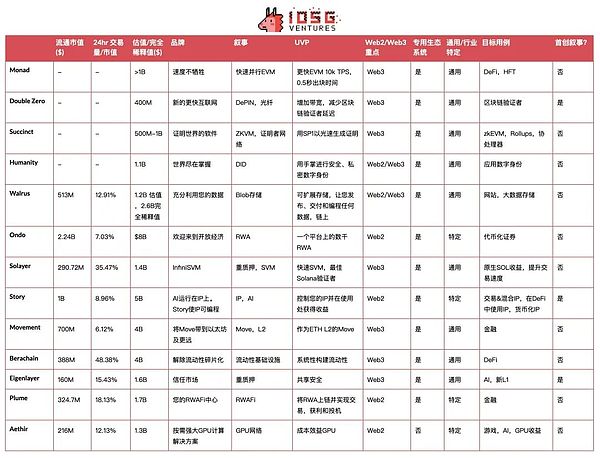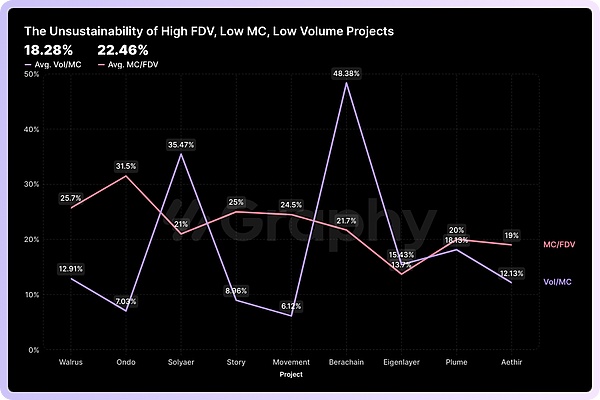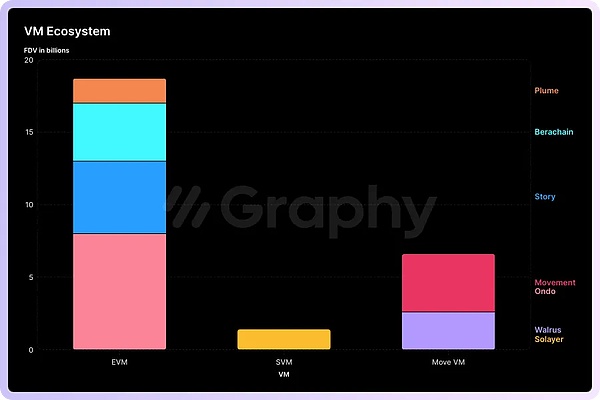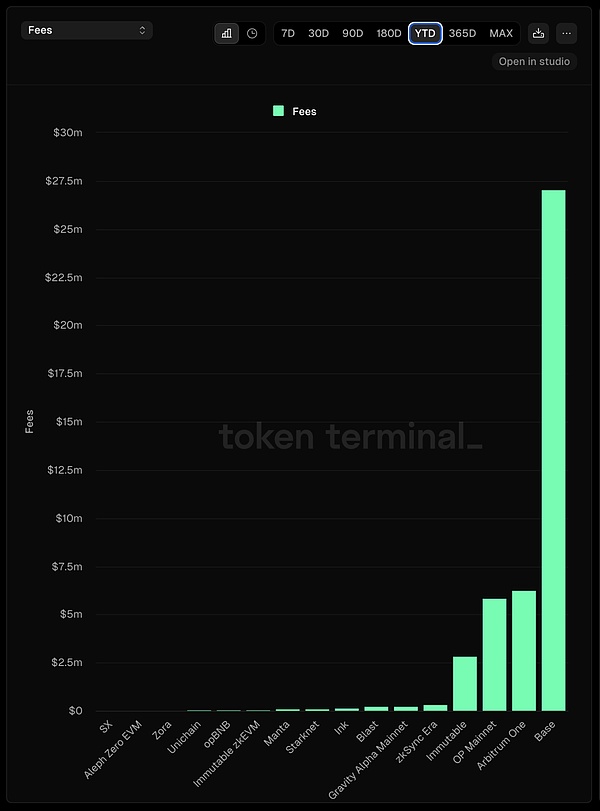The cryptocurrency infrastructure sector is experiencing significant market fatigue.
Written by: Yiping @IOSG
Challenges Facing Crypto Infrastructure
Market Fatigue and Valuation Decline
The cryptocurrency infrastructure sector is undergoing notable market fatigue. After years of explosive growth, the valuations of infrastructure projects are shrinking, and investors are becoming more selective. This trend reflects an increasingly mature market where mere technological innovation is no longer sufficient to achieve high valuations.
Innovation Issues
Today's infrastructure projects face a critical dilemma: most offer similar functionalities with minimal differentiation. Despite technological advancements, we have yet to see breakthrough use cases that can support entirely new categories of applications. The ecosystem struggles to provide compelling value propositions for established Web2 platforms (such as X or Instagram) to migrate to blockchain. Aside from decentralization, there are few reasons for these platforms to fundamentally change their existing operations. This fundamental adoption gap has made trading and speculation the dominant applications for most infrastructure layers, limiting the transformative potential of the sector.
Overbuilding in Infra, Vacant Infrastructure
Many infrastructure projects often focus on pursuing forward-looking technological innovations while neglecting the actual needs of developers. They tend to be overly concerned with elements beyond core functionalities, such as privacy protection, trust assumptions, verifiability, and transparency. This overly advanced technological approach overlooks the importance of short-term market acceptance and practical applications, making early market promotion more challenging and leading to difficulties in obtaining effective user feedback and validation.
The surge in such infrastructure projects has created a paradox — too many platforms competing for too few attractive applications. This imbalance has resulted in a large number of "ghost chains" with extremely low actual usage rates and almost no revenue generation, creating unsustainable economic models that rely primarily on token appreciation rather than genuine utility.
For example, although ZKVM technology is quite advanced, the verifiability it offers does not effectively address the real challenges faced by blockchain at this stage, nor does it promote greater integration of Web2 applications with blockchain technology. Therefore, ZKVM technology currently appears more as an idealized rather than practical infrastructure product.
In contrast, cloud computing directly responds to the validated market demand for efficiently managing server resources with different configurations, times, and locations. This demand already has a relatively mature market foundation, and cloud computing platforms meet developers' practical needs for rapid deployment, elastic scaling, and cost optimization through modular and interface-based server resources, database management, and storage services. By effectively addressing the pain points of enterprises and developers, cloud computing technology quickly gained market recognition and ultimately evolved into a crucial infrastructure supporting the internet economy.
Breaking the Feedback Loop
A healthy crypto ecosystem requires an efficient feedback loop between application developers and infrastructure builders. Currently, this loop has been broken — application developers are hindered by infrastructure limitations, while infrastructure teams lack clear signals to understand which features can drive actual usage. Restoring this feedback mechanism is vital for sustainable growth. Despite these challenges, infrastructure development remains lucrative, with 35 of the top 50 cryptocurrencies by market capitalization maintaining their own infrastructure layers. However, the standards for success have significantly increased — new infrastructure projects must simultaneously demonstrate concrete use cases, substantial user appeal, and compelling narratives to achieve meaningful valuations.
The Most Successful New Infrastructures of the Past Year
Evolution of Blockchain Infrastructure
The previous cycle of blockchain infrastructure primarily focused on addressing the limitations of Ethereum, with projects positioning themselves as "faster and cheaper" alternatives while offering little in terms of truly innovative features. Today, the landscape has changed dramatically, with recently successful projects introducing more diverse and specialized infrastructure solutions.
Most Influential New Projects
Over the past year, several infrastructure projects have achieved remarkable results through TGE or large-scale funding rounds. According to Cryptorank data, these projects represent the most influential new infrastructures in the primary and secondary markets:
Blockchain Infrastructure
Movement: MoveVM Ethereum Layer2
Berachain: Liquidity proof, EVM-compatible Layer1 Monad: High-performance EVM-compatible Layer1
Solayer: Re-staking based on the Solana ecosystem, ultra-fast SVM
Succinct: ZK proof generation network and ZKVM
Emerging Infrastructures
Walrus: Blob storage solution
Aethir: GPU computing network
Double Zero: Decentralized physical fiber optic network facilities
Eigenlayer: Providing Ethereum security for new protocols
Humanity: Digital identity protocol platform
Bridging Web2 and Web3
Ondo: RWA Layer2
Plume: RWAFi blockchain
Story: AI-driven IP programmable platform
Below is an overview table of project data (data as of 2024/4, for reference only):

Core Observations and Analysis
Based on an analysis of recent successful infrastructure projects and the current market environment, the following core observations can be distilled:
Market Maturity and Valuation Restructuring: From Technological Frenzy to Value Return

The most notable feature of the current market is the shift in valuation logic. The early model of attracting investment solely through technological narratives and high FDV (fully diluted valuation) is facing severe challenges.
Unsustainable Token Economic Models
Many projects exhibit characteristics of high FDV, low circulating market capitalization (MC), and low trading volume. This foreshadows that a large number of token unlocks in the future will bring sustained selling pressure, and even if projects make technological progress, price declines due to token dilution may erode user confidence, creating a negative feedback loop. This indicates that a sound and sustainable token economic model is crucial for the long-term health of infrastructure, as important as the technology itself.
Valuation Ceiling and Exit Challenges
Even successful projects seem to face an invisible ceiling of around $10 billion in valuation. This means that for investors, achieving outsized returns (such as 100 times) requires entering at a very early stage (with valuations below $50 million), highlighting the importance of timing and early judgment. The market is no longer easily paying for pure potential but demands clearer proof of value.
Execution Overwhelms First-Mover Advantage
Not all projects that pioneered new narratives achieve the highest valuations. For example, while Double Zero, Story, and Eigenlayer are pioneers in their respective fields, many subsequent projects have achieved comparable or even higher valuations through stronger execution, better market timing, or more optimized solutions. This indicates that in an increasingly crowded market, high-quality execution, effective market strategies, and timing are becoming increasingly important.
Rise of Technological Pragmatism: Focus on Optimization, Integration, and Real Needs
The technological development direction of infrastructure shows a clear pragmatic tendency, with the market favoring solutions that can solve real problems, optimize existing paradigms, or effectively connect to the real world.
Sustained Value of "Faster and Cheaper"
Although the market seeks breakthrough innovations, the demand for optimization of core blockchain performance remains strong. Projects like Monad, Movement, Berachain, and Solayer have achieved significant valuations by enhancing the performance of existing virtual machines (EVM, MoveVM, SVM) rather than introducing entirely new paradigms. This indicates that improvements in speed, cost, and efficiency remain core value points of infrastructure until the next generation of killer applications is found. Network layer optimizations (such as Double Zero) and security enhancements (such as Succinct, Eigenlayer) also fall into this category.

Embracing the Real World, Connecting Web2
Projects that connect with real-world applications and assets demonstrate strong market appeal. Ondo and Plume focus on RWA (real-world assets), while Story emphasizes the programmability of IP (intellectual property), all achieving high valuations. They apply blockchain technology to already validated Web2 concepts (such as asset management and IP commercialization), injecting programmability, global liquidity, and new financial possibilities, lowering the user understanding threshold and broadening application scenarios.
DeFi and AI as Value Anchors
From the perspective of target use cases, finance (DeFi, RWA) and artificial intelligence (AI) are the two areas currently most recognized by the market that can support high-valuation infrastructure. This indicates that infrastructure capable of providing underlying support for these two high-potential areas is more likely to attract capital and market favor.
Some New Narratives Encountering a Chill
At the same time, some previously highly anticipated infrastructure narratives, such as pure gaming chains, Rollup-as-a-Service (RaaS), dedicated validation layers, multi-VM chains, Agent chains, certain DePIN, and Desci, have yet to produce billion-dollar leading projects in this cycle. This may reflect either insufficient technological maturity in these areas or a failure to find clear, large-scale market demand and sustainable business models.
Ecosystem Synergy and Precise Narratives: The Dual Engines of Value Amplification
In addition to technology and market positioning, building a strong ecosystem and effective market communication have become key levers for the success of infrastructure projects.
Network Effects of Ecosystems
The vast majority of projects with valuations exceeding $1 billion are committed to building or integrating into a dedicated ecosystem. Whether it's L1/L2 attracting developers to build applications or providing shared security for other protocols like Eigenlayer, the importance of network effects is evident. Ecosystems with multiple composable projects can create value far exceeding isolated solutions, forming a positive cycle that attracts more users, developers, and capital.
Layered Narratives, Precise Communication
Infrastructure needs to cater to two core groups: end users and developers, whose needs and concerns are vastly different. For end users, complex technology must be transformed into intuitive "experience" stories (such as fast transaction speeds, low costs, and ease of use), emphasizing the direct benefits brought by technology. For developers, a deep explanation of the technology's "capabilities" (such as performance metrics, development tools, scalability, and security) is required, providing professional and precise information for evaluation. Successful projects often adjust their communication strategies based on different audiences to effectively convey their value propositions.
Future Investment Opportunities in Blockchain Infrastructure
Targeting Underserved Web2 Markets
The most promising infrastructure opportunities will focus on large Web2 markets that blockchain solutions have not yet adequately served. These projects can create globally accessible markets while introducing improved financial mechanisms.
Creating New Categories of Infrastructure
Compared to incremental improvements to existing infrastructure, entirely new categories of infrastructure will generate significant value, such as:
Intent-based infrastructure: Protocols that allow users to express desired outcomes rather than specific transactions, automatically handling execution optimization.
Adding privacy to each blockchain, Web3's HTTPS infrastructure
Infrastructure that Meets User Needs and Stabilizes Revenue
As the blockchain industry matures, the long-term value of infrastructure is gradually returning to its core functions: meeting real user needs and generating sustainable revenue. The early market's excitement may have been based on expectations and technological narratives, but ultimately, infrastructure that cannot effectively serve users and establish robust economic models will struggle to sustain itself.
A continuous revenue stream is the lifeblood of a project's healthy operation; it not only needs to cover high operational costs but should also provide actual returns to ecosystem participants (such as token holders and validators), for example, through token buybacks and incentivizing participants. Currently, some leading Layer 2s like Base and Arbitrum have achieved considerable protocol revenue. Base has an annual fee of $27.5M, while Arbitrum and Optimism are around $7M. However, due to changes in investor preferences during this cycle, their token prices remain relatively low, reflecting a mismatch between revenue and valuation. Currently, the top Layer 2s have an FDV that is 500x their annual protocol revenue. They are working to correct this mismatch through measures like token buybacks.

Infrastructure lacking revenue support relies more on selling tokens to sustain team operations. This strategy is difficult to withstand market cycle fluctuations. Stable revenue is a direct proof of the market's ability to solve real problems and provide effective services. For developers, infrastructure can achieve widely applied complex use cases with a hundredfold efficiency or realize functionalities that were previously unattainable; for end users, it can provide a smoother experience, lower usage costs, and richer features.
Web2 Apps Actively Integrating Blockchain
Creating revolutionary applications from scratch requires significant time and resources. A more efficient approach mimics the recent AI revolution: directly integrating blockchain functionality into existing Web2 applications. The astonishing speed of AI adoption is primarily driven not by standalone AI applications but by thousands of established platforms integrating AI capabilities into existing user experiences.
Therefore, blockchain infrastructure must prioritize seamless integration pathways, allowing Web2 applications to gradually implement blockchain functionalities without disrupting their core user experience. The most successful infrastructure will enable familiar applications to offer ownership, transaction, and financial features without requiring users to understand complex blockchain concepts or navigate entirely new interfaces.
Financial incentives may drive this wave of integration. Just as AI capabilities help Web2 companies create advanced tiers and new revenue streams, blockchain integration can unlock new monetization models through tokenization, fractional ownership, and programmable royalties. Infrastructure that makes these benefits easily accessible while minimizing technical complexity will catalyze the next phase of blockchain adoption in mainstream applications.
免责声明:本文章仅代表作者个人观点,不代表本平台的立场和观点。本文章仅供信息分享,不构成对任何人的任何投资建议。用户与作者之间的任何争议,与本平台无关。如网页中刊载的文章或图片涉及侵权,请提供相关的权利证明和身份证明发送邮件到support@aicoin.com,本平台相关工作人员将会进行核查。




